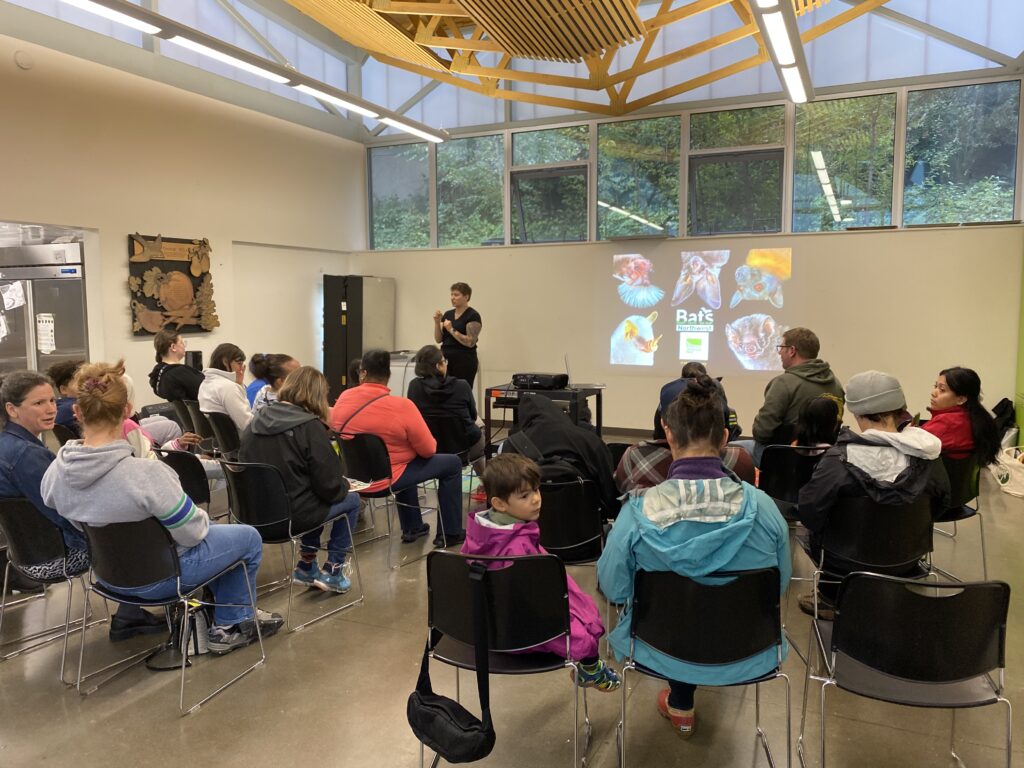Washington state is home to 14 different species of bats, half of which have been spotted hanging around Seattle! Since bats are nocturnal, we don’t commonly see them in our day-to-day activities, but bats are a huge contributor to our ecosystem.
The importance of Bats
Bats play a major role in keeping insects at bay that would otherwise negatively impact our forests, gardens, and natural areas. Bats consume about 1,000 insects per hour and without their help, many insect populations would go unchecked. Bats specifically feed on moths, flies, beetles, and mosquitos, all of which can be harmful to some plants and are generally considered pests to people.

Here in the Pacific Northwest, bats pollinate various types of flowers such as Western Trillium and Common Yarrow. In warmer climates, bats are vital in the pollination process for more than 300 species of fruit. These friends of the forest also support the dispersal of seeds, increasing crop production and preserving native species.
Results from the Woodland Park Zoo bat monitoring program find there are seven species with medium to high levels of activity in Seattle.
- California myotis
- Big brown bat
- Yuma myotis
- Long-legged myotis
- Silver-haired bat
- Hoary bat
- Little brown myotis
This is based on a bat detector that records calls during the night, located in the Family Farm on the south end of the zoo.
Threats Bats are Facing
Although bats are a critical part of our ecology, roughly a fifth of all bat species are considered endangered or vulnerable due to habitat destruction and white-nose syndrome. Deforestation displaces bats from their roosts and makes it difficult for them to forage. Bats roost throughout many native trees, creating colonies and hibernation spaces. They also enjoy ‘snags’ which are standing dead trees, due to the heat they let off during decomposition.

White-nose syndrome (WNS) is a disease caused by cold-loving fungus and was first discovered in the eastern U.S. in 2006. In 2016, WNS was discovered in King County and since then many research groups have been working hard to understand the impacts of this fungi as not all species show signs of infection. White-nose syndrome is typically found on the wings and noses of bats but can spread to other areas. WNS disrupts bats’ hibernation process, causing them to use energy that needs to be preserved, ultimately leading to starvation or prematurely leaving their winter roosts.
What’s Being Done Now?
Several conservation efforts are currently underway from agencies and local organizations to save bats and learn about the various species that live in Washington.

Bats Northwest has a Bat Activity Trends (BAT) Community Science Program open to community members and has installed year-round acoustic monitors in multiple locations across the greater Seattle region to identify species and local habitats. Bats Northwest is a non-profit organization dedicated to protecting bat populations through education and is open to the public for participation.
The Woodland Park Zoo has a team of staff and graduate students who work with Bats Northwest researchers to monitor bat activity on Bainbridge Island. This is part of an effort to gain insight on bat populations and contribute data to the North American Bat Monitoring Program. A graduate student from the Woodland Park Zoo Advances Inquiry Program also created a website, Bat-ivities, that is filled with games, resources, and crafts to learn more about bats.
There are several ways to show your support for bat conservation whether it’s being a community scientist, educating friends and family on bats, or by providing safe roosting areas.
Join Us for Seattle Forest Week!

Preserving forests and parklands are also critical components in bat conservation, so consider participating in our 4th annual Seattle Forest Week! Seattle Forest Week will be happening from October 26th to November 2nd. Seattle Forest Week’s events are great opportunities to join in on planting, forest bathing, bird & plant walks, and helping shape what future participation can look like! This year the theme is Nurturing Forests and Futures: Youth Engagement in Seattle’s Urban Forest.
